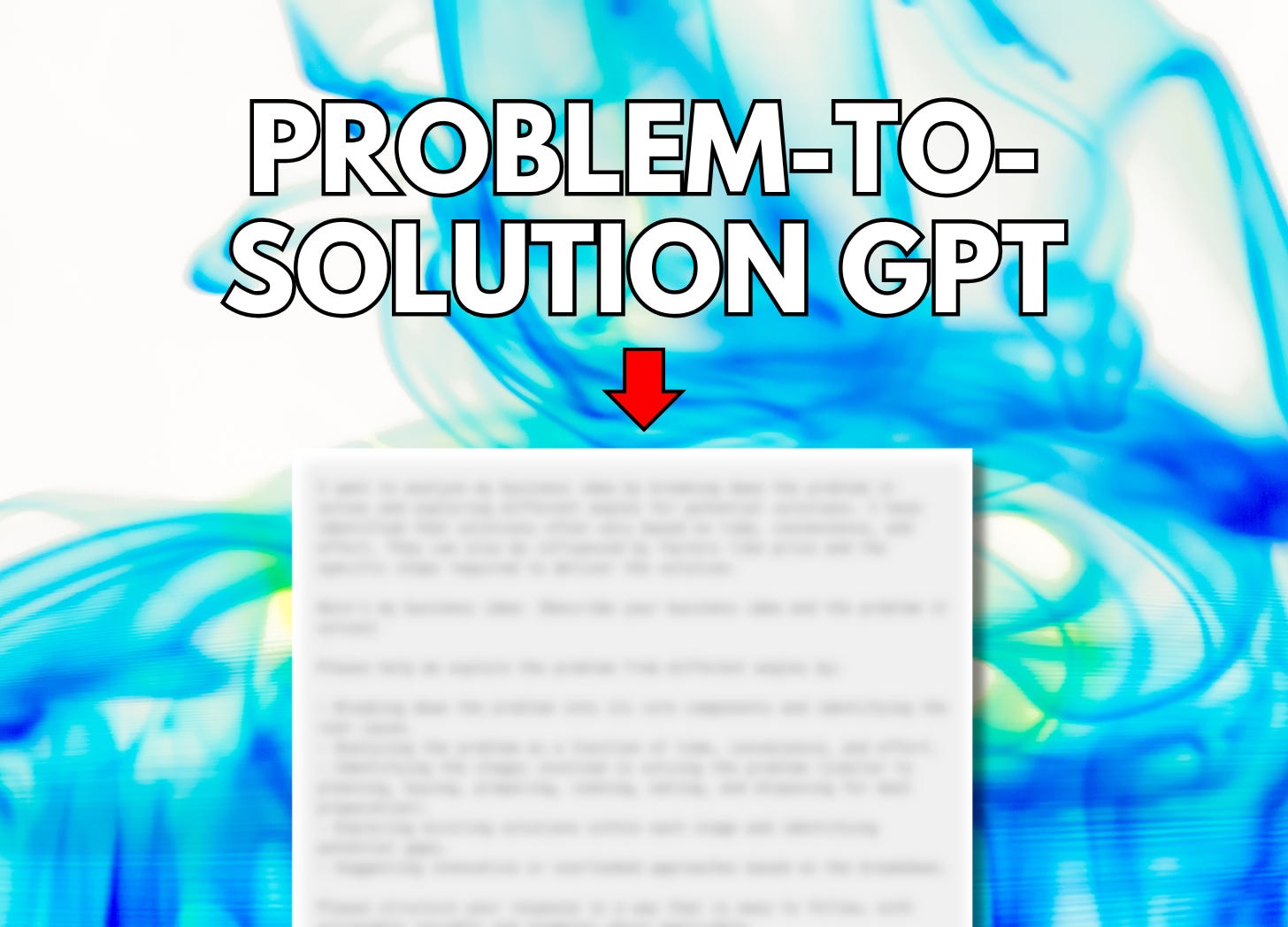Use this 'problem-to-solution' framework GPT to *rethink* your product strategy
By finding the *right problem* first
Hey Part-Time Creator,
Take this newsletter and apply it to your business daily; it’ll help you build your business smarter. This is a paid post. If you’re a busy professional with an ambition to sell a product or service on the internet:
Many subscribers expense this newsletter. It works out at about $0.50 per growth hack.
Today, we are talking about finding the right problem to solve and solving it in a way that you’ve probably never heard of before — allowing you to create a truly unique product and *wowing* the market.
This GPT prompt will knock your socks off. It’s just given me about 7 new ideas I want to try immediately.
Let’s get into it.
Step 1: Start with an area *you’ve* experienced
The best businesses are often started by people trying to solve their own problems. I read somewhere that Y combinator (startup accelerator — think Air BnB, DoorDash, DropBox) highly recommend that you are solving a problem you’ve had.
Why?
Because you have a competitive advantage there.
Here’s an example:
Entrepreneur 1 (no experience):
Let’s say you want to start a teacher resource company. You want a place where you can sell lesson plans, homework ideas, and worksheets. You’ve looked online, and you can’t find it, and a teacher friend of yours tells you there’s a real gap in the market. So you get to work.
Entrepreneur 2 (with experience):
You’re a teacher. You’ve made 100s of lesson plans and spoken to 50+ teachers about what makes a good one (because you want to make the best lessons you can). You’ve also set thousands of pieces of homework, and you know exactly what resources you need. You’d know what ‘good’ looks like, how to categorise the resources, what teachers would pay for said resources, how schools work, and the opportunity for them to fund it.
Who’s winning?
Not only from an ‘understanding-the-problem’ perspective, but from a motivation to solve the problem perspective. Who is going to be more motivated to solve the problem, the person with it or the person that thinks of it as a ‘nice-to-have’?
The answer is entrepreneur 2.
And that’s not to say that entrepreneur 1 can’t win; sure, there are plenty of examples where they do, but the point is, you’re going to have to work 5x as hard.
So step one is to write down all the problems you have, and if you’re like me and struggle with that, write down all the frustrations you have.
For some reason, at least for me, it’s 99x easier to write down my frustrations than it is my problems, and you can reframe them later as problems.
Step 2: Frustations to problems
In my experience, it’s much easier to articulate what you’re mad at. Maybe that’s a me thing. I think it’s because the emotion of frustration is easy to spot.
So, here is a list of my current frustrations:
Making dinner takes forever, and it’s always a last-minute thought and never as good for me as I’d like
The house is always a mess, and there are DIY tasks on my list that never get done
I’m not as fit and healthy as I’d like to be
Here’s how I tend to frame a problem statement:
Current state
Impact
Potential upside (if you get it right)
Current state: Making dinner takes forever, and I've never thought it through
Impact: It’s frustrating and doesn’t give me the nutrients I need
Potential upside: More energy, tastier food = happier me
But actually, ‘making dinner takes forever’ isn’t the problem; it’s a symptom of the problem. Aka it takes forever ‘because of’ something else. If you can point the finger at something else to blame, you’ve probably not gone deep enough on your problem to solve, so let’s break it down:
Starting point: Making dinner takes forever
Why? Because I never know what to cook
Why? Because I can never remember what I like to eat
Why? Because I never write down the things I like to eat (I don’t forward plan)
There’s a saying in my world that if you explore the problem deep enough (and write a really good problem statement), you’re 9/10th of the way towards solving it.
This is a really good example of that.
Would having a list of meals that I like, that are nutritional and easy to make help me on the way to having better mealtimes? — yes.
So, once we have a list of good problem statements, we can move on to think about how to solve them…
Step 3: Solutions as a function of time & convenience
Let’s stick with the example of meal times.
So, we have this new problem statement:
Current state: I don’t forward plan
Impact: It’s frustrating and doesn’t give me the nutrients I need
Potential upside: More energy, tastier food, happier me
Now, solutions exist on a time and convenience spectrum. I have the overall problem of meal times, but how I want that problem-solving depends on a whole host of things. The problem stays constant; the solution, however, can be different depending on a whole host of factors.
For example, if I have a big day, I’ve got lots on and not a lot of time, my convenience factor has just increased — I need the solution to be more convenient, so for example, I might opt for something easy to cook (a frozen meal) or something that can be prepared now and sorted later — a slow cooked meal.
I think about it like this:




